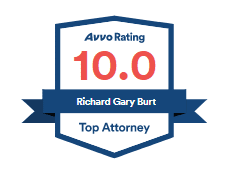
Richard Burt Professional Law Corporation
Mon - Fri: 9 AM - 6 PM
In communicating through a website with a lawyer you are thinking of hiring, you should not provide any confidential information concerning your legal matter until an attorney-client relationship has been formed.
Sending an email to Richard Burt or leaving a voice mail for him or his assistant (and a reply from either) does not create an attorney-client relationship.
No attorney-client relationship will be formed until you and Mr. Burt have agreed that he should represent you, he has determined that there is no conflict with an existing client, you have signed an engagement letter that sets forth the terms of the representation, and, when requested, you have made a fee deposit.
Please note that the initial consultation is solely to determine the nature of your legal matter and to discuss fees. Mr. Burt does not offer free legal advice.
After an attorney-client relationship has been formed, email (and voice mail) may of course be freely used for confidential attorney-client communications.
If we try to call you at a telephone number that you provide to us and are unable to reach you (and your voice mail is full or is not set up), we may text you at that number to let you know that we tried to call you. By sending an email via this website or by calling and leaving a voice-mail message, you consent to receiving such texts. At any time, you may reply STOP to opt-out from further messages.
NOTE: Mr. Burt does not handle litigation of any kind. If you wish to sue someone, are being sued, or need to make a court filing of any kind, Mr. Burt cannot help you. You should not contact him for those services.


Superfluous Text in a Contract Opens Door to Litigation
The recent case of Schron v. Troutman Saunders LLP, from the New York Court of Appeals, New York’s highest court, shows the importance of not including unnecessary verbiage in a contract just because it’s traditional.
In this case, an LLC (“Cam Equity”) was granted an option to acquire 99.999% of the membership units of another LLC (“SVCare”). The option contract described the consideration given for the option as “the mutual covenants and agreements hereinafter set forth, and other good and valuable consideration” [Emphasis added.] This is traditional “legal language.”
Under the terms of the agreement, Cam Equity had until June 2011 to exercise the option at the strike price of $100 million.
The option agreement also contained a clause (known to lawyers as a merger or integration clause), which stated:
This Agreement contain[s] the entire agreement and understanding of the Parties . . . and supersedes and completely replaces all prior and other representations, warranties, promises, assurances and other agreements and understandings (whether written, oral, express, implied or otherwise) among the Parties with respect to the matters contained in this Agreement.
This clause is standard in most contracts written by lawyers, and it is intended to limit the rights and obligations of the parties to the terms set forth in the agreement. A rule of law, the parol evidence rule, prevents parties from introducing evidence that varies or contradicts the terms of a written agreement like this one, an agreement that recites it sets forth all the terms.
In addition to the option contract, there was a loan agreement under which Cam III, an entity related to Cam Equity, agreed to lend $100 million to SVCare.
The loan agreement and the option contract were executed on the same date in December 2004 and amended on the same day in June 2006 as part of a refinancing of the Mariner transaction. Subsequently, the relationship between the parties went south.
Cam Equity sought to exercise the option, but SVCare claimed that the option was unenforceable because Cam Equity’s option was contingent Cam III’s lending SVCare $100 million, which SVCare claimed was never lent.
SVCare claimed that the language in the option contract was ambiguous and that SVCare should be permitted to adduce evidence showing that (1) the parties intended the “other consideration” to mean the $100 million loan obligation between Cam III and SVCare and (2) the loan was never funded. Cam Equity objected to any such evidence because it would be an effort to change the terms of the option by inserting an additional condition (a $100 million loan from a related entity) on the parties’ agreement.
The court of appeals found that the recital of “other good and valuable consideration” did not render the option contract ambiguous or incomplete. It therefore rejected SVCare’s argument that it should be permitted to introduce evidence to show that the parties intended to include the $100 million loan obligation (set forth in a separate agreement between Cam III and SVCare) as consideration for the option.
The court noted that parties to the option were sophisticated business entities, represented by counsel, and if they intended to make the $100 million loan payment a condition to the enforceability of the option, they could have included a provision to that effect.
Lessons Learned
The recital that the consideration includes “other good and valuable consideration” is common, but that is not good reason for it to have been included in the agreement. Consideration in a contract that contains mutual promises is supplied by the mutual promises. There is no need to refer to unstated “other good and valuable consideration,” which adds nothing to the enforceability of the contract. Under the California Civil Code (and probably under the law of New York), a recital of consideration is not binding, and an absence of consideration can always be shown.
While all the terms of an agreement should, of course, be set forth in the contract, adding language that is not needed can create a problem where none would otherwise exist. While SVCare’s argument was weak, it nonetheless opened the door to litigating in the trial court, the intermediate appellate court, and ultimately, the high court of New York.



